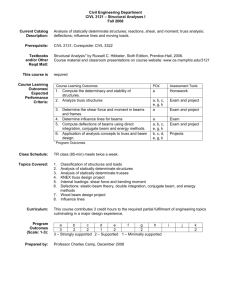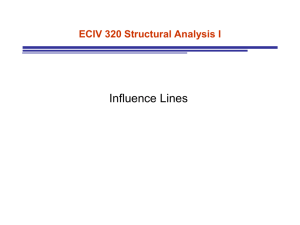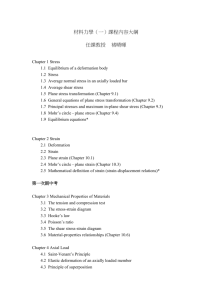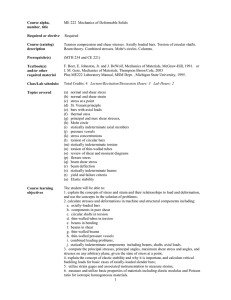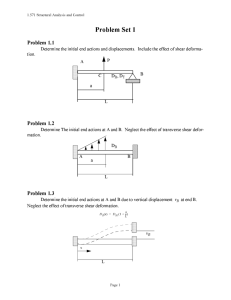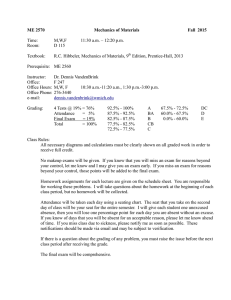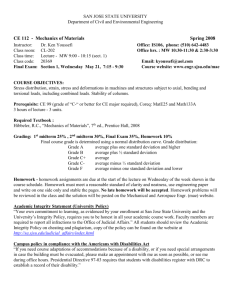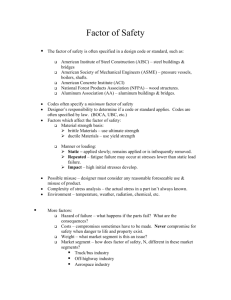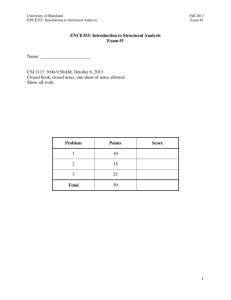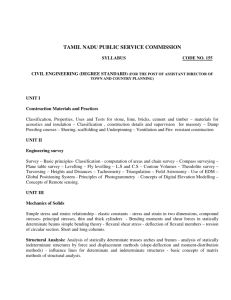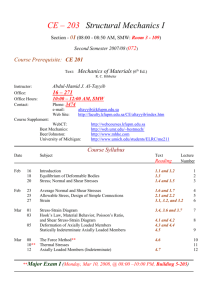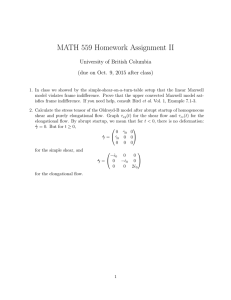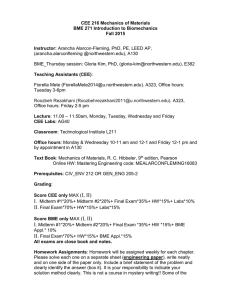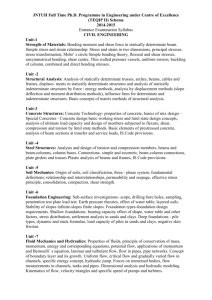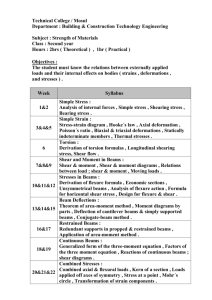ENFD-375 - Basic Strength of Materials
advertisement
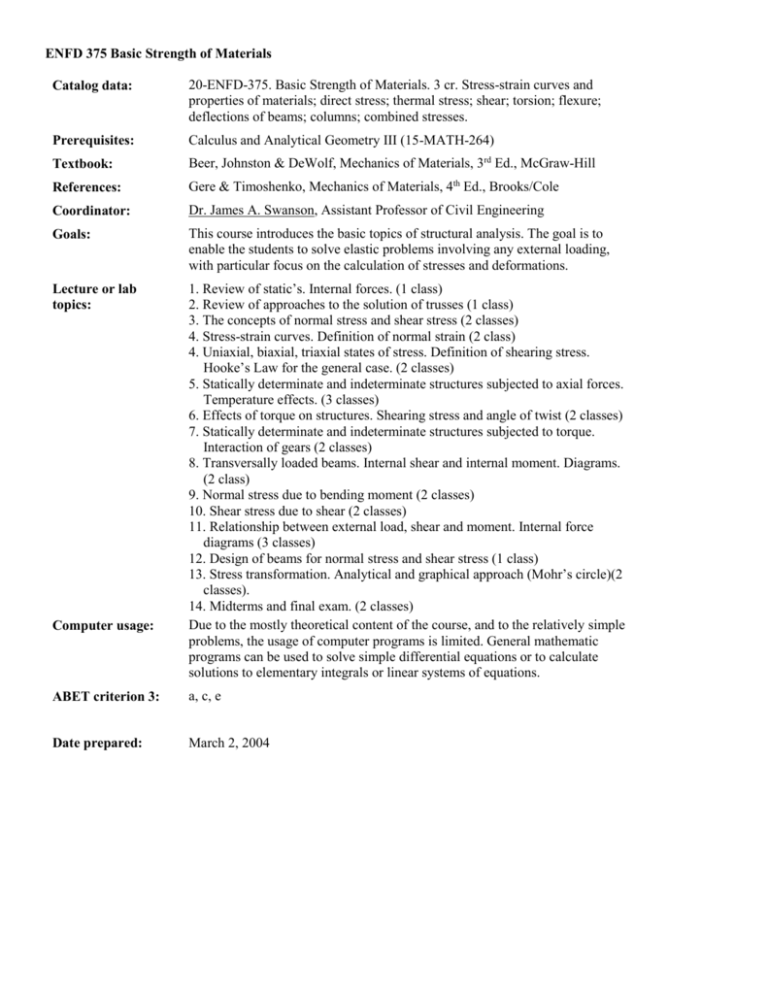
ENFD 375 Basic Strength of Materials Catalog data: 20-ENFD-375. Basic Strength of Materials. 3 cr. Stress-strain curves and properties of materials; direct stress; thermal stress; shear; torsion; flexure; deflections of beams; columns; combined stresses. Prerequisites: Calculus and Analytical Geometry III (15-MATH-264) Textbook: Beer, Johnston & DeWolf, Mechanics of Materials, 3rd Ed., McGraw-Hill References: Gere & Timoshenko, Mechanics of Materials, 4th Ed., Brooks/Cole Coordinator: Dr. James A. Swanson, Assistant Professor of Civil Engineering Goals: This course introduces the basic topics of structural analysis. The goal is to enable the students to solve elastic problems involving any external loading, with particular focus on the calculation of stresses and deformations. Lecture or lab topics: 1. Review of static’s. Internal forces. (1 class) 2. Review of approaches to the solution of trusses (1 class) 3. The concepts of normal stress and shear stress (2 classes) 4. Stress-strain curves. Definition of normal strain (2 class) 4. Uniaxial, biaxial, triaxial states of stress. Definition of shearing stress. Hooke’s Law for the general case. (2 classes) 5. Statically determinate and indeterminate structures subjected to axial forces. Temperature effects. (3 classes) 6. Effects of torque on structures. Shearing stress and angle of twist (2 classes) 7. Statically determinate and indeterminate structures subjected to torque. Interaction of gears (2 classes) 8. Transversally loaded beams. Internal shear and internal moment. Diagrams. (2 class) 9. Normal stress due to bending moment (2 classes) 10. Shear stress due to shear (2 classes) 11. Relationship between external load, shear and moment. Internal force diagrams (3 classes) 12. Design of beams for normal stress and shear stress (1 class) 13. Stress transformation. Analytical and graphical approach (Mohr’s circle)(2 classes). 14. Midterms and final exam. (2 classes) Due to the mostly theoretical content of the course, and to the relatively simple problems, the usage of computer programs is limited. General mathematic programs can be used to solve simple differential equations or to calculate solutions to elementary integrals or linear systems of equations. Computer usage: ABET criterion 3: a, c, e Date prepared: March 2, 2004 Specific Examples of ABET Criteria 3 a: The assigned homework covers a wide range of problems associated with the theoretical topics analyzed in class, and include problems for the solution of which a moderate level of engineering judgment is required. The solution of the proposed problems requires extensive use of the mathematics and calculus background of the students, as well as ingenuity and intuition. c: The covered topics and the assigned homework explicitly involve the design and/or the verification of a simple structural system or of an assembly of simple structural systems, including the design process necessary in order to obtain a structure compatible with given deformability or stress constraints. e: The very nature of the topics covered by the course requires the students to become able to identify, formulate and solve the given structural problems. Specific Examples of ABET Criteria 8 a: Basic knowledge of trigonometry, analytic geometry, linear algebra and calculus are necessary for the solution of the vast majority of the problems assigned during the course, and the students need to apply all these theoretical topics on practical problems. d: The topics taught in this course will allow the students to be able to actively participate in the design process possibly involved in the professional component of the curriculum. Instrument of Assessment Course Name: Basic Strength of Materials Quarter_______________________________ Outcome Objective HW Course # ENFD-375 Instructor_____________________________ Quiz MidTerm Final Report a) An ability to apply knowledge of mathematics, science, and engineering to problems in the aerospace disciplines b) An ability to design and conduct experiments, as well as to analyze and interpret data c) An ability to design an aerospace system, component, or process to meet desired needs d) An ability to function on multidisciplinary teams e) An ability to identify, formulate, and solve engineering problems in the aerospace disciplines f) An understanding of professional and ethical responsibility g) An ability to communicate effectively in written and oral presentation h) The broad education necessary to understand the impact of engineering solutions in a global and societal context i) A recognition of the need for an ability to engage in life-long learning j) A knowledge of contemporary issues through participation in a general education program k) An ability to use the techniques, skills, and modern engineering tools necessary for engineering practice l) Enhanced understanding of the relationship between theory and professional practice through the cooperative education experience m) The opportunity to specialize and to participate in a research experience Notes: 1) Please attach a list of assignments, quizzes and exams. 2) Please add comments or concerns regarding the present assessment. 3) Please provide any comments or suggestions for improvement. Oral % of Stud. with C and above Comments

